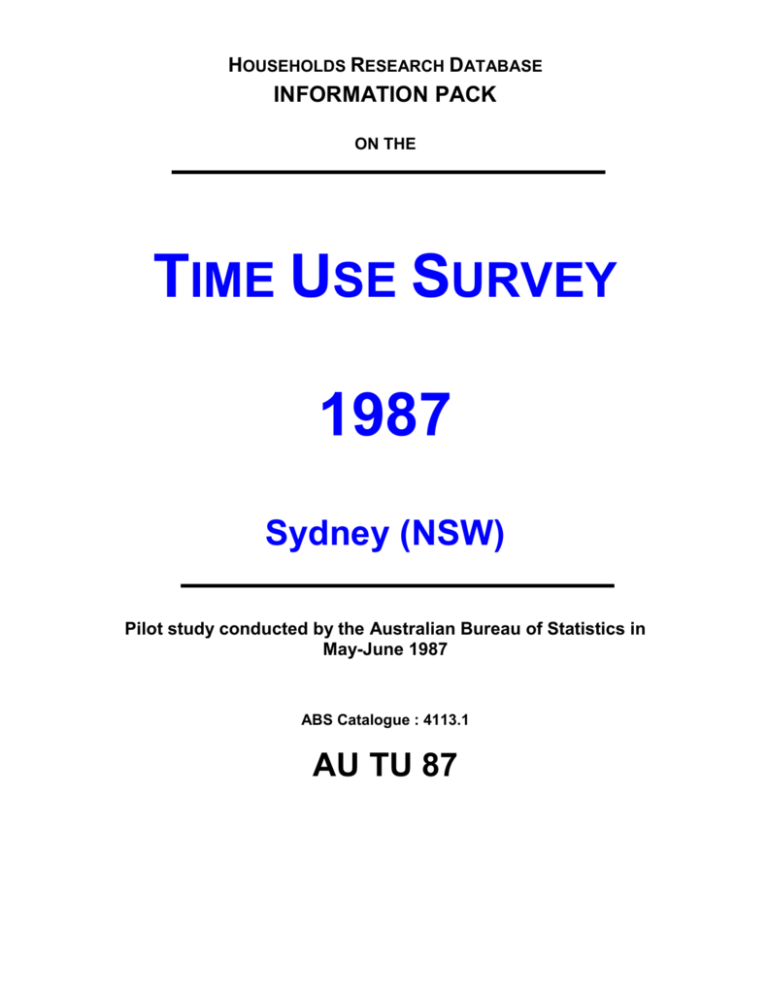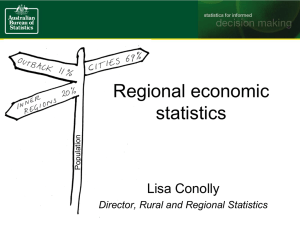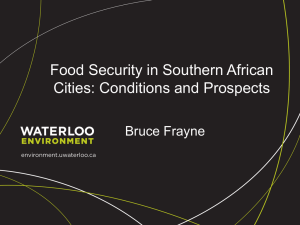TIME USE SURVEY
advertisement

HOUSEHOLDS RESEARCH DATABASE INFORMATION PACK ON THE TIME USE SURVEY 1987 Sydney (NSW) Pilot study conducted by the Australian Bureau of Statistics in May-June 1987 ABS Catalogue : 4113.1 AU TU 87 1987 TIME USE SURVEY Time Use Survey 1987 - Australia Time use surveys are designed to measure the time spent by respondents on all major activities during a reference period. In some cases, additional information, such as time of day at which various activities are undertaken, are also recorded. Interest in time use data has focused mainly on their use in studies of economic and social well-being, the division of labour between males and females, the productive activities of household members and the needs of special interest groups. To investigate some of these issues the Australian Bureau of Statistics (ABS) conducted pilot time use study in May - June 1987. Objectives of Time Use Survey The main objectives of the 1987 Time Use Survey (TUS) were: to test collection methodologies which may be appropriate to the conduct of a future ABS national time use survey to assess the feasibility, costs and possible methodology for a national Time Use Survey; to provide detailed information on the activities that occupy people outside the paid workforce; to detail how households spend their time and develop a picture of the day-to-day distribution of labour in a significant number of households; and to measure the daily activity patterns of males and females, including time spent caring for children and frail, sick and disabled persons. Years Conducted And Periodicity In 1974 and 1987 pilot surveys with selected samples were conducted. The 1992 TUS was the first national survey of time use conducted in Australia. In 1997 a second national survey of time use in Australia was conducted. Sample Residents of private dwellings from Sydney, Australia were included in the survey. The 1987 survey sampled 1000 Sydney households and provided detailed information on how people spend their time. The time use survey, conducted over the period 23 May to 4 June, covered about 1000 private dwellings in the Sydney Statistical Division. All persons aged 15 and over living these dwellings were included in the sample except members of the permanent defence forces and overseas residents. Brief Description of Method 2 1987 TIME USE SURVEY Information was obtained in the TUS partly by interview (which collected basic demographic and socio-economic characteristics) and partly by self-completion time use diaries (which collected information on the activities in which people engaged and the time they spent on them). Trained ABS interviewers collected information from an adult member of the selected household for all persons aged 15 years or more in the household. A diary was then left for each of these persons to record their activities over two days. Respondents to the survey completed a 2-day diary in which they were asked to list any activities undertaken (up to a maximum of 3) in each 15-minute period. The first activity in each period was deemed to be the 'primary activity'. Type of Data Collected The1987 Time Use Survey examined how people in Australia allocate their time to different kinds of activities. It provides information on the time Australians spend on paid work, unpaid household work, parenting, leisure activities, fitness and health activities, travel and community participation. TYPE OF DATA 1987 TIME USE SURVEY COLLECTED HOUSEHOLD Household Type GEOGRAPHIC Sydney Statistical Division Regions DEMOGRAPHIC Sex Age Martial Status Birthplace and year of arrival Number of children aged 0-11 in household Number of children aged 0-4 in household Number of children aged 5-9 in household Number of children aged 10-11 in household Family Status ACTIVITY Activities undertaken Status of activity Timing of activity Duration of activity Day of activity Location of activity Mode of transport Company present Payment for activity 3 1987 TIME USE SURVEY EDUCATION Educational attainment INCOME Government persons or benefits received Main source of income Total personal annual gross income LABOUR FORCE Labour force status Whether employed/not employed Status of worker Occupation Whether wanted to work Whether looked for work in the last twelve months Time since last job Reason for leaving last job Occupation in last job Status of worker in last job Full time or part time status in last job Intention to look for work in next twelve months Type of work preferred Main reason for not actively looking for work All reasons for not looking for work Reason for not available to start work within four works Persons not in the labour force summary variable Persons not in the labour force activity variable Marginal attachment summary variable Brief Description of Structure of Data files Access to the original ABS hierarchical data file containing a subset of variables at the household, person and person-day levels can be arranged for associates. However, for easier manipulation this file has been divided into four SPSS data files - episode, activity, person and household files. These files can be merged using common identifiers. Specifically, the episode file contains the start and finish times or individual durations for all the activities undertaken by the respondents on the two diary days. The variable uniqueid identifies cases in this file. This file contains 72,761 time use episodes. In contrast, the activity file is an aggregate time use file. In this file the time episodes (in minutes per day) each person spent on a particular activity have been summed to produce aggregate figures for each activity code. This file is also uniquely identified by uniqueid. This file contains no demographic information either at the person or household level. Each respondent has two entries - one for diary day one and one for diary day two. There are 1,611 cases in this file. 4 1987 TIME USE SURVEY Please note that a percentage of respondents did not complete the two diary days. The person file, which is uniquely identified by uniqueid, contains all the demographic person level information for the respondents. There are 1,611 person records in this file. Merging any combination of the above files is possible via the common identifier, uniqueid. Prior to any analysis a review of the documentation file is imperative for both experienced and novice researchers in the area. The documentation file contains a list of all the variables, including names and coding information, that appear in the above files. Further Information For further information please refer to: Australian Bureau of Statistics (1988) Information Paper: Time Use Pilot Survey Sydney, May-June 1987, Catalogue No. 4111.1, ACT. Australian Bureau of Statistics (1990) Measuring Unpaid Work: Issues and Experimental Estimates, Catalogue No. 5236.0, ACT. Bittman, Michael (1991) Juggling Time : How Australians Families Use Time, Report on the Secondary Analysis of the 1987 Pilot Survey of Time Use, Office of the Status of Women, Department of the Prime Minister and Cabinet, CPN: ACT. 5 1987 TIME USE SURVEY Access to the TUS unit record files To access unit record and documentation files for the 1987 Time Use Survey, Research Associates must complete the attached Application to Access to the Australian Time Use Survey, 1987 form and return it to the Database Manager, at the following address: Database Manager Households Research Database Department of Economics University of Melbourne VICTORIA 3010 AUSTRALIA Tel: +61 03 8344 0807 Fax: +61 03 9349 4291 Mode of access to unit record files Unit record files in the HRD collection can be zipped and posted to an email address, written to CD-ROM or accessed on computers at HRD research centers. Alternatively, the ABS has made available unit record files via secure internet based query systems, namely Remote Access Data Laboratories (RADL) and ABS Site Data Laboratories (ABSDL). Research Associates can submit syntax, either via the web or on ABS equipment, to the ABS and attain statistical output in return. RADL can be accessed either in basic format, which contains a similar level of detail as the CD-ROM, or in expanded format, containing greater level of detail than previously available. Section 2 of the application form requires the applicant to indicate which mode of access is required. Access to background documentation files It is imperative to gain access to the original documentation file as this file contains variable names and coding information necessary for the analysis of any of the TUS unit record files. As a result, all Research Associates who order unit record data from the HRD will also receive the documentation file. The original ABS documentation file has a reference code of AU TU 87 DOC .txt. Other ABS publications, including the published results and the user guide, can also be accessed by completing Section 3A of the application form. 6 1987 TIME USE SURVEY Format of unit record files The TUS unit record files can be saved in various formats, including SPSS, ASCII, SAS or Excel. Research Associates can select the format required on the application form in Section 3B. Please contact the Database Manager if you require the unit record files in a format that is not specified on the application form. Unit Record Files required Research Associates who access unit record files either on CD-ROM or zipped to email, can order the files they require by completing Section 3C of the application form. The following table outlines the unit record files that are available. File Description Sample HRD Reference Code Complete file Contains episode, person and household data at the episode level, includes weights 72,761 episode records AU TU 87 COM Episode file Contains episode data 72,761 episode records AU TU 87 EPI Activity file Contains activity level data, includes weights 3,222 diary days AU TU 87 ACT Person File Contains person and household level data 1,611 persons AU TU 87 PER Please note that the Episode, Activity and Person files can be merged using unique identifiers. Sub sets of the files Subsets of any of the above data files can be constructed for Research Associates. If you are interested in constructing individualised files for your research firstly review the documentation file, then contact the Database Manager, who will supply you with the appropriate aggregated file. 7 THE UNIVERSITY OF MELBOURNE Department of Economics Households Research Unit HOUSEHOLDS RESEARCH DATABASE Application for Access to the 1987 Australian Time Use Survey AU TU 87 1 Background Details Full Name Research Associate Member Number Please print in BLOCK LETTERS 2 Mode(s) of Access Required Please indicate each of the mode(s) of access required. From the HRD From the ABS Please tick one mode only Please tick all modes required CD, please complete Section 3. RADL Basic Zipped Files, please complete Section 3. RADL Extended A computer at one of the HRD Research Centres ABSL data laboratories 3 File Order Form A. Background Files The following standard .txt and .bat files will be included in all requests. Documentation File AU TU 87 DOC.txt Please indicate with a tick if you require the following ABS .pdf files. AU TU 87 USG.pdf ABS Users Guide ABS Published Results AU TU 87 PUB.pdf ASCII SAS Excel AU TU 87 ALL Person File AU TU 87 PER B. Format for Unit Record Files Please indicate with a tick the format required SPSS C. Unit Record Files Required Please indicate with a tick the unit record files that you require* Complete File Episode File Activity File AU TU 87 EPI AU TU 87 ACT *For truncated unit record files containing selected variables please contact the Database Manager 4 I will use the above unit record files for the following statistical purposes: 5 The Undertaking NOW I, (Full Name in BLOCK LETTERS) HEREBY UNDERTAKE that I will comply with the conditions of use for unit record files in the Households Research Database collection outlined in Schedule 1 and certify that I have signed all relevant ABS applications and undertakings to obtain access to the 1987 Time Use Survey unit record files. SIGNATURE: DATE: THE UNIVERSITY OF MELBOURNE Department of Economics Households Research Unit HOUSEHOLDS RESEARCH DATABASE SCHEDULE 1 CONDITIONS OF ASSOCIATION TO THE HOUSEHOLDS RESEARCH DATABASE Terms and Conditions relating to the use of Households Research Database’s (HRD) unit record files collection As a Research Associate of the HRD I will adhere to the following conditions when using or accessing any unidentified individual statistical unit record files in the collection. Specifically, as an Associate I will: only access unit record files when the appropriate documentation has been completed for the relevant statistical organisation. use each of the unit record data files in the collection for statistical purposes only. “Statistical purposes” means use of the unit record files to produce information of a statistical nature. Examples of such uses are: The manipulation of the unit record files to produce means, correlations or other descriptive summary measures; The estimation of population characteristics from the unit record files The use of the unit record files as input to mathematical models and for other types of analyses(e.g. factor analysis) and To provide graphical or pictorial representations of characteristics of the population or subsets of the population; take all reasonable measures to protect the unit record files from unauthorised use, replication, distribution or publication. not attempt to identify particular persons or organisations in any of the Australian or international unit record files. not attempt to match the unit records with any other lists of persons or organisations. not disclose, either directly or indirectly, the unit record files to any other person or organisation outside the Households Research Database and its participating institutions. comply with any other direction or requirement specified by the relevant statistical organisation and/or the Database Manager of the HRD. ensure that the data is returned to the Household Research Database facility when I have completed my project and any copies made of the data during the analysis will be destroyed.






